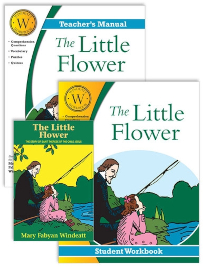TAN Books is the publisher of twenty biographies of Catholic saints, written in the 1940s by Mary Fabyan Windeatt. These are substantial books with more than 150 pages each. They might be read independently by children in about fourth grade and above and read aloud to younger children. To help Catholic parents incorporate these biographies into their curriculum, TAN Books has created student workbooks and teacher's manuals for five of the books:
- The Little Flower
- Saint Benedict
- Saint Louis de Montfort
- Saint Rose of Lima
- The Children of Fatima
The student workbook generally has a set of activities for each chapter in the biography, although sometimes one set of activities covers two or more chapters. Those activities always include key terms, vocabulary activities, and comprehension questions. The vocabulary sections have sentences with bolded vocabulary words, and children are to write a synonym or definition that fits the context. The comprehension questions ensure that students are grasping the main ideas and significant details in the story. Some sets of workbook activities include an optional activity, most commonly a series of questions whose answers are then to be found within a word-search puzzle. Other activities are unique to the story. For example, in the workbook for The Little Flower, students design a holy card and write a prayer to go on it.
Three multi-part quizzes also provide a substantial amount of the workbook activity. Each quiz uses a crossword puzzle to test vocabulary. Key terms are tested as students match terms and definitions from two columns. Multiple-choice questions check reading comprehension. Finally, a narration exercise asks students to write two or three sentences in answer to a question such as, "What analogy did Therese's sister Pauline, use to explain the complete happiness of all those who were in heaven? (p. 23). Each workbook has a final essay assignment at the end that asks children what virtues that saint displayed and how the student might emulate them in their own lives.
The workbooks are intended for grades two through five, but parents need to adapt or skip some activities with younger students who might lack sufficient reading and writing skills. For instance, parents might have children answer questions orally rather than in writing, or they might work with them on puzzles.
The teacher's manuals have a brief explanation of how to use the workbook plus answer keys (or sample responses) for activities and quizzes.
Each of these studies works on language arts skills, but spiritual formation should be the primary goal. With that in mind, parents should feel free to adapt the workbook activities in ways that best meet the needs of their children.








